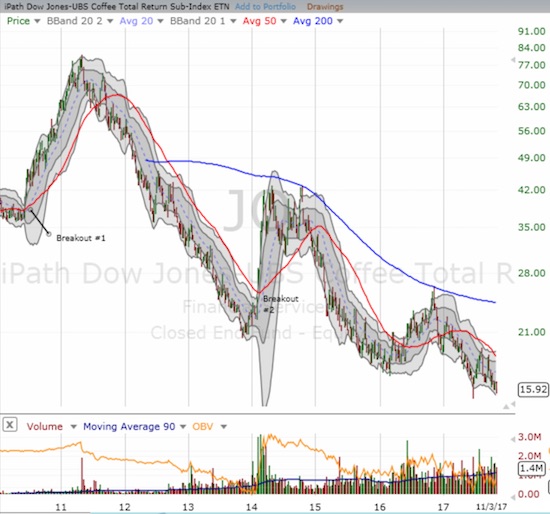According to Hanna Neuschwander, the Communications Director for the World Coffee Research, demand for coffee will double, while over that same timeframe climate change will cut in half the land area available for growing coffee. A little over a month ago, I launched a trade in iPath Bloomberg Coffee SubTR ETN (JO) as a play on the June lows holding in the face of strong, secular demand for coffee. Suddenly, I like this trade a LOT more even as JO continues to struggle around all-time lows.

Source: FreeStockCharts.com
A recent article in the Washington Post called “The Race to Save Coffee” goes into lurid detail about the struggles to save the coffee industry from the ravages of climate change. The prospects look dire, but there is potential in increasing the number of varieties of coffee plants. Coffee has 36 varieties, a paltry number compared to a crop like watermelon and its 3000 varieties.
There is hope in “F1 hybrids.” They demonstrate “hybrid vigor” and generate very high yields. Yet, only one of these hybrids, Centroamericano, has made it into scaled planting and is still a very tiny fraction of overall production. I am guessing the market that prices coffee is placing a LOT of high hopes on the success of science or is simply unable to price in the risks of a process playing out over the next several years.
Read the Washington Post article for more details or watch the following video for a summary of the issues and the potential solutions.
(hat tip to a friend who sent me the Washington Post article)
Be careful out there!
Full disclosure: long JO

The Post article says “Starbucks has sold coffee made from F1 hybrids as part of its small-lot premium brand. Last spring, a batch of Centroamericano grown on a Nicaraguan family farm scored 90 out of 100 points in that country’s prestigious tasting competition, which some in the industry heralded as a major victory.”
I haven’t been in a Starbucks in a while, and until this article I wouldn’t have been interested to try a drink brewed from F1. I wonder if any readers have experienced it and can compare it to regional Arabica varieties?
I would love to know the answer as well since I am not a coffee drinker. 🙂